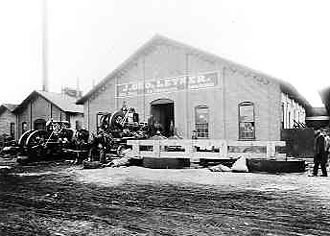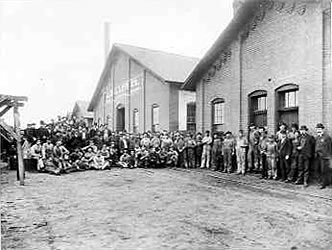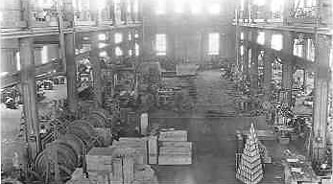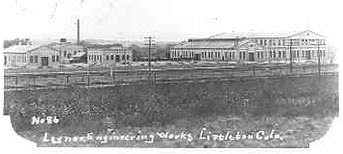Leyner Engineering Company
J. George Leyner, the son of Mr. and Mrs. Peter A. Leyner, was born August 26, 1860 on his father's ranch in Left Hand Canyon, Boulder County, Colorado, the oldest of seven children. His father was from Dachenheim, Germany; his mother, possibly "Pennsylvania Dutch" (German) was born in Pennsylvania. He grew up on the ranch and attended school through eighth grade, at most. He lost an eye in an accident with dynamite as a youth. Yet he developed a major machinery manufacturing plant, owned numerous patents and amassed a fortune.

J. George Leyner Engineering Works. This photo, from January 1903, was most likely taken soon after the plant was completed.
He worked in engineering jobs in Black Hawk, Longmont and Denver before becoming the sole owner of a machine shop in 1891. In the mid-1890s he began to develop mining equipment, including rock drills and compressors. An article by Ardis Webb in The Denver Post Empire Magazine, April 22. 1979, described the next few years: "In 1894 he moved the business to larger quarters at 17th and Wynkoop Streets. In 1897 the manufacturing portion moved to 36th and Wazee, and the offices were in the old Albany Hotel on 17th Street ... In 1902 he again outgrew his quarters and decided to incorporate as the J. George Leyner Engineering Works Company." Littleton was eager to attract new industry and employ workers. The "Industrial League," a group of enthusiastic Littleton businessmen, raised the money to buy and give to Leyner thirty-five acres at 5101 South Rio Grande Avenue if he would built a new plant and relocate there. The Littleton Independent of the time indicates that it was local businessmen who contributed the funds, (at least $3,000), for the land purchase. No mention has been found in the newspaper that the city also donated money. It was expected the Leyner workforce would more than triple the men employed in and around Littleton. Leyner had to agree to spend at least $110,000. By the time the plant was completed in 1903 he had spent $150,000.

J. George Leyner Engineering Works, January 1903.
The Independent announced in May 1906 that the office force had finished moving from their main office in Denver to the Littleton plant. Only the sales rooms remained in Denver. The Littleton plant employed 168 people. By 1908 it was a nine-building complex. The company had won the grand prize at the St. Louis Exposition in 1904 for its air drills, compressors and hoisting machinery. This was excellent advertisement, and Leyner machinery became familiar to mining men the world over. Again, Webb: "Leyner's name became forever linked with the drill he invented which allowed water and air to enter the hollow drill, thus removing the rock cuttings and dust so dangerous to early miners' health."
George Leyner remarried in 1912 to Lina May Covington, apparently his second wife, and built a new home at 13th and Fillmore in Denver. Webb says that at this time three children were taken into the Leyner home. In her 1979 article, she named them as, (in 1979), Irene Pinkerton, deceased, J. George Leyner, Jr., of Denver and Betty Dine of Golden, Colorado. George Leyner, Jr., said in a later interview with the Littleton Historical Museum that he never knew his mother and that Lina was his stepmother. He said that he had two stepsisters. They may have been children of Lina. At this point in the research it is not known what happened to the first wife of George Leyner, Sr.

Inside the Leyner Engineering building, c.1905.
In 1912 in an agreement between Leyner and the Ingersol-Rand Company of Pennsylvania, the latter became the sole distributor of Leyner products with exclusive rights to build rock drills under Leyner patents. Under terms of the contract, Leyner discontinued making rock drills and compressors and turned to the manufacture of drill-steel sharpeners, oil furnaces and small hoists. With the money he received from Ingersoll-Rand for his patents, he purchased the Perry Park Ranch in Douglas County for $37,500. There he raised pigs and crops, used the ranch for mechanical experiments and invented the "Linapede" tractor. Webb says that he learned that there were seven million farms in the United States but only 250,000 tractors. His successes had been built on seeing a need and filling it. Now he saw another golden opportunity in the Linapede tractor for producing improved machinery for the American and European agricultural industry.
By 1915 the Ingersoll-Rand engineers were doing most of the designing for the Leyner Company, but he continued as a consultant.
George Leyner liked automobiles. He owned several including an "Orient," a motorized buckboard and a Parry roadster. He was a large man, described as dominating, extremely stubborn, especially in overcoming difficulties in the plant, honorable, trustworthy, a wonderful man, ingenious, extremely competent, a fine neighbor. In 1918 he sold both the Perry Park Ranch and the Denver home and moved to the "Shepperd house" at 2233 West Shepperd in Littleton. At age fifty-eight he organized a new company, the Leyner Tractor and Manufacturing Company, with an office in the Tramway Building in Denver.
On August 3, 1920 J. George Leyner suffered a fatal accident when he swerved his car to avoid a horse and wagon. The accident occurred directly in front of the Ingersol-Rand plant as the horse shied at a passing train. Leyner was pinned beneath his car and died of his injuries two days later at his home at 6050 South Windermere. He was survived by his wife and the three children, his brothers, Frank M. of Eugene, Oregon, Charles P. of Denver, Albert M. of Lafayette, Colorado and three sisters, Mrs. Nora K. Hartman, Mrs. Hattie M. Howell and Mrs. Blanche S. Duncan, presumably of Denver.

Leyner Engineering Works postcard; postmark 1907.
Webb says that Leyner was actively promoting his new tractor when he died. He was well known and respected in manufacturing and financial circles by then. Much stock in his new company had been sold, and the tractor was ready for production. She explains that sometime between May 1919 and June 1932 the Leyner Company was liquidated and absorbed by Ingersol-Rand; the company's papers for this period are not complete.
After her husband's death, Lina and the children lived in several Littleton houses. One was next door to Dr. W. C. Chrysler at 1890 West Littleton Boulevard. "They were financially well-off, but the widow apparently lacked the experience to retain the fortune," says Webb. The family moved to the Capitol Hill area in Denver at some point, and Lina ran the Hal Sayre mansion at 801 Logan as a rooming house. She remarried in 1922 to Eugene Kaiser. They were divorced in 1928. George, Jr., graduated from Littleton High School in 1928 and spent his career with the Denver Union Water Company.
Along with his many inventions of large-scale machinery, George Leyner, Sr., is credited with the design of the device that made shredded wheat. The Littleton Historical Museum has copies of a number of his patents.
In 1931 Ingersol-Rand closed the Littleton plant. The Civilian Conservation Corps (CCC), a Depression-era public works program, used it for its local headquarters in 1935. It was the headquarters for thirteen Wyoming and thirty-three Colorado CCC camps. The O. K. Co-Operative Rubber Welding System bought the site in 1945. They in turn sold the buildings to the Electron Corporation in 1948. Electron made a major expansion including a machine shop, sheet metal operations and foundries with electric furnaces. The August 14, 2003 Littleton Independent showed a photograph of the Electron building being demolished and the caption, "Demolition of the former foundry began in July and was expected to take 4-6 weeks. The property is currently used for residential living and commercial use.
Bibliography
Ditson, J. D. Untitled, undated clipping from Compressed Air Magazine. Reprinted, Littleton Independent. Littleton, Colorado, December (1938?). Littleton Museum. Vertical File, Biography: Leyner.
Leyner, George, Jr., Interview. May 27, 1977. Abstract of tape, Littleton Museum. Vertical File: Oral History. George Leyner, Jr.
Littleton (Colo.) Independent. Littleton Independent Publishers, December 26, 1902, January 9, 1903, August 6, 1920, 50th Anniversary Edition, 1938.
Littleton Museum. Card File: John George Leyner.
____. Photographic Archives.
____. Vertical File, Biography: Leyner.
Simmons, R. Laurie and Thomas H. Simmons. "Historic Buildings Survey, Littleton, Colorado, Littleton Townsite of 1890." Survey Forms. Three volumes. Denver: Front Range Research Associates, Inc., 1997, 1998.
Webb, Ardis. "The Forgotten Legacy of J. George Leyner." In The Denver Post Empire Magazine, April 22, 1979. Clipping, Littleton Museum. Vertical File, Biography: Leyner
Photographs courtesy of the Littleton Museum, unless otherwise noted; to order copies, contact the Museum at 303-795-3950.
Compiled by Doris Farmer Hulse
Updated April 2021 by Phyllis Larison